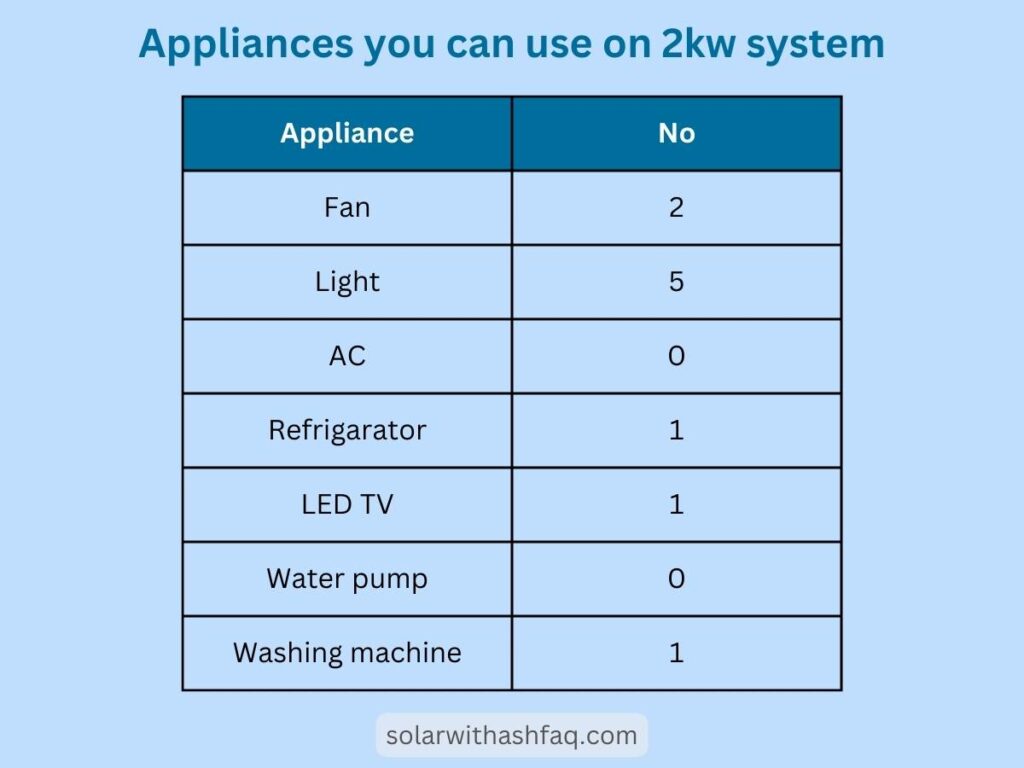Complete Guide to 2kW Solar Panel Price in India with Subsidy
If you’re considering a 2kW solar system for your home in India, it’s essential to understand the costs involved—both with and without government subsidies.
A 2kW system is perfect for small households that can reduce your electricity bills.
However, the cost can vary depending on the type of system you choose: on-grid, off-grid, or hybrid.
This guide will break down the costs, highlight the benefits of each system type, and help you make a confident decision that aligns with your energy needs and budget.
2kW Solar System Price Without Subsidy
This capacity is ideal for small households, accommodating 1 to 3 occupants, and can effectively support a 2 BHK home with common appliances.
The price of a 2 kW solar system in India differs based on the type of system installed.
Here’s a breakdown of the pricing:
| System Type | Price |
|---|---|
| 2kW On-grid solar system | Rs. 144,000 |
| 2kW Off-grid solar system | Rs. 160,000 |
| 2kW Hybrid solar system | Rs. 310,000 |
2kW Solar Panel System Price in India With Subsidy
Under the PM Surya Ghar Muft Bijli Yojana, government subsidies significantly reduce the price of a 2 kW solar system in India.
Below is the overview of how the PM solar scheme applies to different solar system types:
| Rooftop Solar System Capacity | Applicable Subsidy (₹) |
|---|---|
| 1 kW | 30,000/- |
| 2 kW | 60,000/ |
| 3 kW and Above | 78,000* |
Now, what is the effect of the final prices of solar systems after including this subsidy?
Here is how it goes:
2kW On-Grid Solar System:
- Price Before Subsidy: Approximately ₹144,000
- Subsidy Applicable: ₹60,000.
- Price After Subsidy: Approximately ₹1,35,300
2kW Off-Grid Solar System:
- Price: Approximately ₹160,000
- Subsidy Applicable: Not applicable.
- Price After Subsidy: Remains ₹160,000.
2kW Hybrid Solar System:
- Price Before Subsidy: Approximately ₹310,000
- Subsidy Applicable: ₹60,000.
- Price After Subsidy: Approximately ₹250,000.
Solar System Types Covered in Subsidy
Under the government’s subsidy schemes in India, on-grid and hybrid solar systems are eligible for financial assistance, making them more affordable for homeowners.
Specifically, these systems can receive a subsidy of ₹30,000 per kW to reduce the overall installation costs.
In contrast, off-grid solar systems do not qualify for subsidies, meaning homeowners must bear the full cost of these systems.
Why is the Off-Grid Solar System not eligible for Subsidies?
Off-grid solar systems are not eligible for government subsidies in India primarily because the government aims to promote grid-connected solar installations.
By providing subsidies for on-grid and hybrid systems, the government can achieve two goals.
First, it supports the transition to renewable energy, and second, it ensures that excess energy produced can be utilized effectively within the grid.
In contrast, off-grid systems, which operate independently and require significant investment in battery storage, do not align with this policy framework.
Setup Required for 2kW Solar Panel System
To set up a 2 kW solar panel system, you will need the following components:
Solar Panels
- Number of Panels: 6-8 solar panels, each with a capacity of 330-400 watts
- Total Panel Capacity: 2 kW
Inverter
- Inverter Capacity: 2-3 kW
- Type: Grid-tied inverter for on-grid systems, hybrid inverter for off-grid systems
Mounting Structure
- Area Required: 100-150 square feet of shade-free rooftop space
- Mounting Type: Roof-mounted or ground-mounted, depending on available space
Cables and Connectors
- DC Cables: To connect solar panels to the inverter
- AC Cables: To connect the inverter to the home’s electrical system
- MC4 Connectors: To connect the solar panels
Battery Bank (for Off-Grid Systems)
- Battery Capacity: Depends on energy storage requirements
- Battery Type: Lead-acid or lithium-ion batteries
Combiner Box
- Combines the output from multiple solar panel strings
- Provides overcurrent protection
Charge Controller (for Off-Grid Systems)
- Regulates the voltage and current from the solar panels to the batteries
- Prevents overcharging and over-discharging of batteries
Grounding and Lightning Arrestor
- Provides protection against electrical surges and lightning strikes
How Many Units Can a 2kW Solar Panel System Generate?
In optimal conditions, such as during summer months with ample sunlight, a 2 kW system can produce up to 6 kWh daily.
While in less favorable conditions, such as winter, it may generate as low as 3 kWh per day
| System Size | Daily Output | Monthly Output | Yearly Output |
|---|---|---|---|
| 3 kW | 6 kWh | 180 kWh | 2100 kWh |
Solar panels should be oriented towards the south to capture the maximum amount of sunlight throughout the day.
Also, adjusting the tilt angle to the optimal value can increase the annual efficiency output by 10-30% compared to a fixed horizontal installation.
The tilt angle of solar panels should be approximately equal to the location’s latitude.
For example, in New Delhi, the optimal tilt angle would be around 28.6 degrees
You May Read: 3kW Solar Panel Price in India (Detailed Guide 2024)
What Appliances Can Be Run on a 2kW Solar System?
A 2 kW solar system can power various appliances in a small to medium-sized home.
Lighting
Refrigeration
Entertainment
- 1 LCD TVs (42″ each) for 5 hours per day
- 1 laptop for 3 hours per day
- WiFi router for 24 hours per day
Kitchen Appliances
Other Appliances
- 1 washing machine for 2-3 hours per day

It’s important to note that a 2 kW system cannot simultaneously power larger appliances like refrigerators and washing machines.
How Much Can a 2kW Solar System Save on Your Electricity Bills?
The savings generated by a 2 kW solar system can vary greatly based on the type of system installed—on-grid, off-grid, or hybrid.
On-grid systems generally offer the highest savings.
While off-grid systems provide energy independence through battery storage, they usually yield lower savings.
As they do not benefit from net metering.
Here’s an analysis of how much you can save:
Savings on Electricity Bills
Assuming an average electricity tariff of ₹8 per unit, a 2 kW solar system can save you around ₹1,680 to ₹2,500 per month on your electricity bills.
Over a year, the savings can amount to ₹20,160 to ₹29,2500.
Payback Period
With the help of government subsidies, a 2 kW solar system costs around ₹1,44,000 to ₹2,00,000.
Assuming an annual electricity bill savings of ₹30,000, the system can pay for itself in 4-5 years.
Concluding Remarks
In summary, this guide has provided a comprehensive overview of the solar scheme.
So, investing in a 2kW solar system in India is a smart choice for small households.
By choosing the right system—whether on-grid, off-grid, or hybrid—you can optimize your savings and energy independence.
FAQs
Yes, a 2kW solar panel system can run 1-ton air conditioner, but only for a few hours each day.
The subsidy for a 2kW solar system in India is ₹60,000. This subsidy applies to grid-tied solar systems and is part of the Central Financial Assistance (CFA) program.
For a 2kW solar system, you typically need around 8 batteries rated at 12V-100Ah to store the energy generated. The exact number may vary based on your storage needs.
You can purchase 2kW solar panels from various solar energy companies across India. It’s advisable to connect with local solar providers or trusted online platforms to get quotes
After applying the subsidy, the price of a Tata 2kW solar power system is approximately ₹84,000. The total price before subsidy ranges from ₹1,44,000 to ₹1,80,000.

Content Writer | Assistant Manager (Electrical) at IESCO
As a passionate content writer, I’m on a mission to make solar hassle-free for you through my expert guides and easy-to-digest content.

